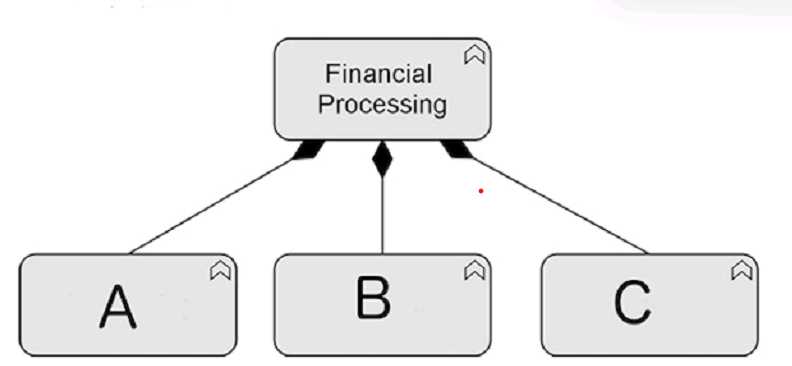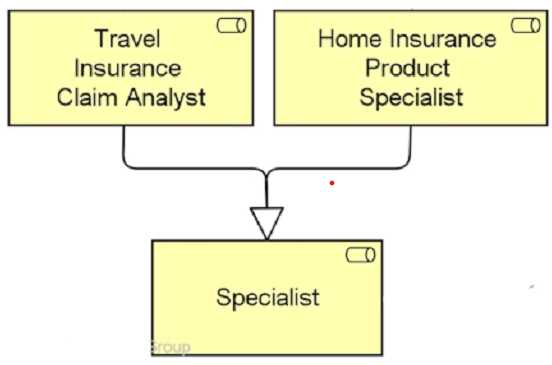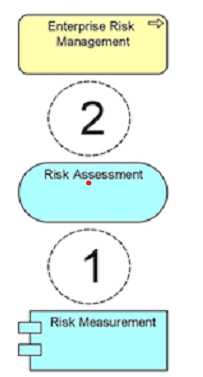the open group oga-031 practice test
ArchiMate 3 Part 1
Question 1
What relationship is allowed from a technology function to an application function?
- A. Assignment
- B. Aggregation
- C. Influence
- D. Realization
Answer:
A
Explanation:
According to the ArchiMate® 3.2 Specification1
, an application function describes the internal
behavior of an application component, and an application component may be assigned to an
application function, which means that the application component performs the application
function. Therefore, the correct answer is A. Assignment.
This relationship indicates that an instance
of a technology function performs (part of) the behavior of an instance of an application function1
.
Question 2
None
- A. Which statement describes how the Capability element is used?
- B. To represent an asset owned by an organization
- C. To represent what an enterprise has decided to do.
- D. To represent the relative worth, utility, or importance of a core element.
- E. To represent the ability that an active structure element possesses
Answer:
D
Explanation:
According to the ArchiMate® 3.2 Specification1
, a capability represents an ability that an active
structure element, such as an organization, person, or system, possesses.
Capabilities are typically
aimed at achieving some goal or delivering value by realizing an outcome1
. Therefore, the correct
answer is D. To represent the ability that an active structure element possesses.
Question 3
What are external active structure elements also called?
- A. Services
- B. Interfaces
- C. Resources
- D. Capabilities
Answer:
B
Explanation:
According to the ArchiMate® 3.2 Specification1
, external active structure elements are also called
interfaces.
An interface represents a point of access where one or more services are offered by an
active structure element to its environment1
. Therefore, the correct answer is B. Interfaces.
Question 4
Consider the following symbol, which represents information about a transformation project.
What concept does this symbol represent?
- A. A principle
- B. A constraint
- C. A goal
- D. A requirement
Answer:
A
Explanation:
According to the ArchiMate® 3.2 Specification1
, a principle defines a general property that applies to
any system in a certain context.
A principle is a normative property of all systems in a given context
that expresses a fundamental value or property1
. Therefore, the correct answer is
A. A principle.
Question 5
What physical element is used to model buildings that have an important role in production
processes?
- A. Facility
- B. Manufacturing Plant
- C. Distribution node
- D. Equipment
Answer:
A
Explanation:
According to the ArchiMate® 3.2 Specification1
, a facility is a physical element that is used to model
buildings that have an important role in production processes.
A facility represents a physical
structure or environment1
. Therefore, the correct answer is A. Facility.
Question 6
Consider the following diagram which shows part of the ArchiSurance Claims Administration:
Which of the following correctly describes this diagram?
- A. The event Claim Filed triggers the Accept Claim process which is serviced by the Customer Service Representative role before the Assign Claim process.
- B. The Claim Filed event assigns the Customer Service Representative to participate in the Accept Claim and Assign Claim processing.
- C. The information that flows from Claim Filed to Accept Claim and then to Assign Claim is reviewed by the Customer Service Representative role.
- D. Business event Claim Filed triggers a business process Accept Claim which in turn triggers an Assign Claim process.
Answer:
D
Explanation:
The correct answer is D. Business event Claim Filed triggers a business process Accept Claim which in
turn triggers an Assign Claim process. This is because the diagram shows a business event (Claim
Filed) that initiates a business process (Accept Claim) which is performed by a business role
(Customer Service Representative). The business process then triggers another business process
(Assign Claim) which is also performed by the same business role. The diagram does not show any
information flow or assignment relationships between the elements.
Question 7
Relationships are classified in a number of categories as shown below What are A, B and C?
- A. Aggregation, assignment, realization
- B. Derived, Internal, External
- C. Passive, Behavior, Active
- D. Structural, dependency, dynamic
Answer:
D
Explanation:
This is because the diagram shows the three main categories of relationships in ArchiMate:
structural relationships, which model the static construction or composition of concepts; dependency
relationships, which model how elements depend on or use other elements; and dynamic
relationships, which model the temporal or causal connections between elements.
Question 8
Which of the following is a composite element?
- A. Grouping
- B. Course of Action
- C. Aggregation
- D. Contract
Answer:
A
Explanation:
This is because a grouping is a composite element that aggregates or groups other elements based
on some common characteristic or purpose. A course of action is a motivation element that
represents an approach or plan for achieving some goal. An aggregation is a structural relationship
that models the whole-part hierarchy between elements. A contract is a passive structure element
that represents a formal or informal specification of an agreement between a provider and a
consumer that specifies the rights and obligations associated with a product or service.
ased on the ArchiMate 3 documents or objectives, a grouping is a composite element that consists of
other concepts, from one or more aspects or layers of the ArchiMate language. A grouping can be
used to model a logical or physical grouping of elements that belong together based on some criteri
a. A grouping can itself aggregate or compose other groupings, leading to a hierarchy of these
elements.
Reference: ArchiMate® 3.2 Specification, Chapter 4 Generic Metamodel, Section 4.1 Behavior and
Structure Elements, Subsection 4.1.5 Composite Elements 1; Composite Elements | Enterprise
Architect User Guide 2
.
Question 9
Consider the following diagram:
Which of the following is the correct description of the diagram?
- A. The financial processing function aggregates the three sub-functions Al B, and C.
- B. The financial processing function is influenced by the three sub-functions A, B, and C_
- C. The financial processing function is assigned the three sub-functions A, B, and C.
- D. The financial processing function is composed of three sub-functions A, B, and C.
Answer:
D
Explanation:
Based on the ArchiMate 3 documents or objectives, the diagram uses a composition relationship to
indicate that the financial processing function consists of three sub-functions A, B, and C. A
composition relationship is a type of structural relationship that represents a whole-part hierarchy
between elements. The notation for a composition relationship is a solid line with a filled diamond at
the end that points to the whole element.
Reference: ArchiMate® 3.2 Specification, Chapter 4 Generic Metamodel, Section 4.1 Behavior and
Structure Elements, Subsection 4.1.2 Structural Relationships 1
.
Question 10
In the Implementation & Migration elements metamodel, which is the only element that models
behavior?
- A. Gap
- B. Plateau
- C. Work Package
- D. Deliverable
Answer:
C
Question 11
Consider the following diagram:
Which of the following correctly describes this diagram?
- A. The two business roles Travel Insurance Claim Analyst and Home Insurance Product Specialist are specializations of the business role Specialist
- B. The business role Specialist approves all claims handled by the two business roles Travel Insurance Claim Analyst and Home Insurance Product Specialist
- C. The two business roles Travel Insurance Claim Analyst and Home Insurance Product Specialist together realize the business role Specialist.
- D. The business role Specialist is an aggregation of the two business roles Travel Insurance Claim Analyst and Home Insurance Product Specialist.
Answer:
A
Explanation:
Based on the ArchiMate 3 documents or objectives, the diagram uses a specialization relationship to
indicate that the two business roles Travel Insurance Claim Analyst and Home Insurance Product
Specialist are more specific versions of the business role Specialist. A specialization relationship is a
type of structural relationship that indicates that an object is a specialization of another object. The
notation for a specialization relationship is a solid line with an empty triangle at the end that points
to the more general element.
Reference: ArchiMate® 3.2 Specification, Chapter 4 Generic Metamodel, Section 4.1 Behavior and
Structure Elements, Subsection 4.1.2 Structural Relationships 1
; ArchiMate Specialization
Relationship - ArchiMate Quick Guide - GitBook
.
Question 12
Which of the following is a Passive Structure Element?
- A. Application Component
- B. Actor
- C. Event
- D. Data Object
Answer:
D
Explanation:
Based on the ArchiMate 3 documents or objectives, a data object is a passive structure element that
represents a piece of data that can be manipulated by behavior elements such as application
functions or services. A passive structure element is a structural element that cannot perform
behavior. Active structure elements can perform behavior on passive structure elements.
Reference: ArchiMate® 3.2 Specification, Chapter 4 Generic Metamodel, Section 4.1 Behavior and
Structure Elements, Subsection 4.1.1 Active Structure Elements 1; ArchiMate® 3.2 Specification,
Chapter 10 Application Layer, Section 10.2 Passive Structure Elements 1
.
Question 13
Consider the following diagram:
What correctly describes this diagram?
- A. Four technology functions realize technology function A The first function Administrate Replication triggers the other three functions in parallel
- B. Technology process A aggregates four technology services. The Administrate Replication service is broken down into three other services.
- C. Technology function A is composed of four technology processes. The technology process Administrate Replication reads information from the three other processes.
- D. Technology function A is composed of four technology functions. Information flows from Administrate Replication to the other functions.
Answer:
D
Explanation:
Based on the ArchiMate 3 documents or objectives, a technology function represents a collection of
technology behavior that can be performed by a node. The diagram uses a composition relationship
to indicate that technology function A consists of four other technology functions. The notation for a
composition relationship is a solid line with a filled diamond at the end that points to the whole
element. The diagram also uses an information flow relationship to indicate that information is
exchanged from Administrate Replication to the other functions. The notation for an information
flow relationship is a dashed line with an open arrowhead at the end that points to the direction of
the flow.
Reference: ArchiMate® 3.2 Specification, Chapter 4 Generic Metamodel, Section 4.1 Behavior and
Structure Elements, Subsection 4.1.2 Structural Relationships
; ArchiMate® 3.2 Specification,
Chapter 11 Technology Layer, Section 11.2 Behavior Elements
; ArchiMate® 3.2 Specification,
Chapter 5 Relationships, Section 5.5 Other Relationships
; ArchiMate Patterns – Technology Layer –
General Geekery
.
Question 14
Complete the sentence. The ArchiMate standard provides a set of entities and relationships for
1. modeling detailed workflow
2. providing fine-grained descriptions of business motivation
3. representing Architecture Description
4. supporting a fixed set of diagram types
Answer:
C
Explanation:
Based on the ArchiMate 3 documents or objectives, the ArchiMate standard provides a set of entities
and relationships for representing Architecture Description. Architecture Description is a work
product used to express an architecture for a system-of-interest. The ArchiMate language is an open
and independent modeling language for Enterprise Architecture that is supported by different tool
vendors and consulting firms.
Reference: The ArchiMate® Enterprise Architecture Modeling Language | The Open Group Website
;
ArchiMate® 3.2 Specification, Chapter 1 Introduction, Section 1.1 Objective
.
Question 15
A Risk Assessment service provided by a Risk Measurement application enables actuaries to assess
and mitigate financial risks as part of the Enterprise Risk Management process
Which combination of relationships, when added to this diagram, would best represent this
situation?
- A. Realization and 2. Serving
- B. Realization and 2. Assignment
- C. Realization and 2. Realization
- D. Serving and 2. Realization
Answer:
A
Explanation:
Based on the ArchiMate 3 documents or objectives, a realization relationship indicates that an entity
plays a critical role in the creation, achievement, sustenance, or operation of a more abstract entity.
A serving relationship models that an element provides its functionality to another element. The
diagram should use a realization relationship from the Risk Assessment service to the Enterprise Risk
Management process to indicate that the service realizes the process. The diagram should also use a
serving relationship from the Risk Measurement application to the Risk Assessment service to
indicate that the application serves the service.
Reference: ArchiMate® 3.2 Specification, Chapter 5 Relationships, Section 5.1 Structural
Relationships 1; ArchiMate® 3.2 Specification, Chapter 5 Relationships, Section 5.2 Dependency
Relationships 1
; ArchiMate Notation: Part 8 – Relationships - ArchiMate Resources for FREE
.